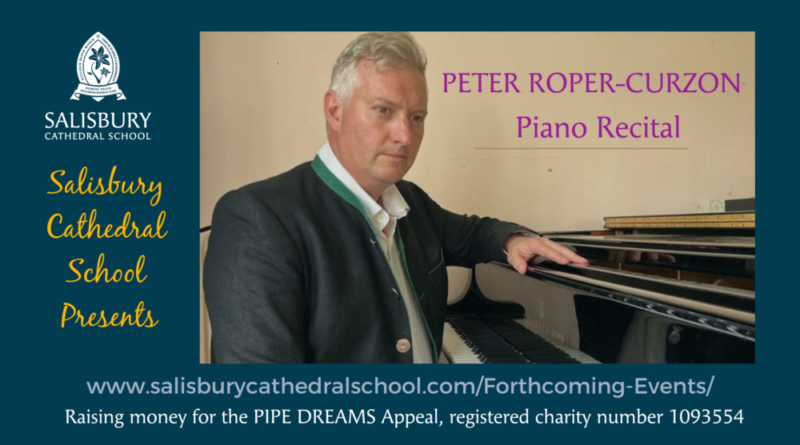Piano Recital by Peter Roper-Curzon
Join Peter Roper-Curzon – concert pianist, organist, composer, and arranger – for an enchanting piano recital at 7.30pm on Thursday 1 February 2024.
Peter is an alumnus of Salisbury Cathedral School. He started his musical career as a chorister here and also first began to learn the organ as a pupil under the tutelage of David Halls. Highlights of Peter’s career include being a finalist at the 1996 BBC Young Musician of the Year competition, Organ Scholar at LMH College, Oxford, and Director of Music at St John’s, Notting Hill. Peter was the organist for the wedding of Princess Eugenie at St. George’s Chapel, Windsor in 2018.
Programme
Beethoven – Sonata No.21 in C (Waldstein)
- Allegro con brio
- Introduzione: Adagio molto
- Rondo:Allegretto moderato-Prestissimo
Bach/Busoni
Chaconne in D minor from violin partita No.2 BWV 1004
INTERVAL
Wine and elderflower cordial available to purchase
Schubert – Impromptus
- G flat major No.3 Op.90
- E fat major No.2 Op.90
Chopin – Waltzes
- A Minor No.19 B.150
- C Sharp minor No.2 Op.64
Chopin – Sonata No.3 in B minor Op.58
- Third movement: Largo
- Finale: Presto non tanto
Concert Notes
The Waldstein Sonata is a symphony masquerading as a piano sonata. It was dedicated to Beethoven’s great friend and patron, Count Ferdinand Ernst Gabriel von Waldstein. It was composed during Beethoven’s middle period, known as his ‘Heroic’ period 1803-12 and a set a standard for piano composition in the ‘grand manner’ supercharged energy is characteristic of such glorious mid-period works such as the Kreutzer violin sonata. Waldstein is a concert work of uncommon effectiveness even by Beethovenian standards. The first movement marked Allegro con Brio, elicits a steam engine affect in its surging rhythms and headlong forward momentum. There’s no ‘slow movement’ in the usual sense, but an Adagio Molto introduction that provides a moment of respite before launching into the utterly magical rondo finale, featuring an innovative use of the damper pedal that creates a shimmering acoustic nimbus around the main reprise, repeats of which are contrasted with propulsively athletic episodes,the whole capped off by a madcap coda.
Bach’s Chaconne in D minor forms the concluding movement of his solo Violin Partita No.2 BWV 1004 and brings to perfection the great baroque tradition of violin writing which included composers such as Arcangelo Corelli. Giuseppe Tartini and Antonio Vivaldi and inspired great violin makers such as Antonio Stradivari and Giuseppe Guanari. Facing the daunting prospect of approaching so hallowed a piece from the violin repertoire for pianistic usage, Busoni’s approach is understandably circumspect and as respectful as it is adventurous. First he takes his lead from Bach’s own transcription for organ of his G minor fugue for the violin and sketches an organ transcription of the Chaconne; he then employs his resplendent pianistic resources in transforming this imaginary organ transcription into a sumptuous concert version for piano.
Schubert Impromptus are pieces that were part of an early 19th century genre of small ‘character’ pieces. Cultivated by composers of the Romantic era, these pieces present a simple musical idea in an intimate lyrical style with the aim of evoking a particular mood or moment of personal reflection, spontaneously experienced and communicated.
Chopin’s waltzes were written for the Parisian salon, for a sophisticated audience of artists and aristocracy. Though more ‘lighthearted’ than most of his other compositions, they bear the unmistakable genius of Chopin: refined and exquisite pianism, brilliance and melancholy, sorrow and joy go hand in hand. The third and final sonata by Chopin was completed in 1844 and dedicated to Countess Emilie de Perthuis. The work is considered to be one of Chopin’s most difficult compositions, both technically and musically.
Date/Time
1 February 2024 - 7:30 pm - 9:30 pm
Location
Salisbury Cathedral School BSR
Ticket Prices:
£20 adults, £15 for over 65s, and £10 for U18s.
Tickets available from:
https://salisburycathedralschool2.beaconforms.com/form/12b0448d
Member
Event Contact
Rowen Gower
gower.r@salisburycathedralschool.com
07855814937
https://www.salisburycathedralschool.com/Forthcoming-Events/

